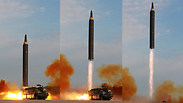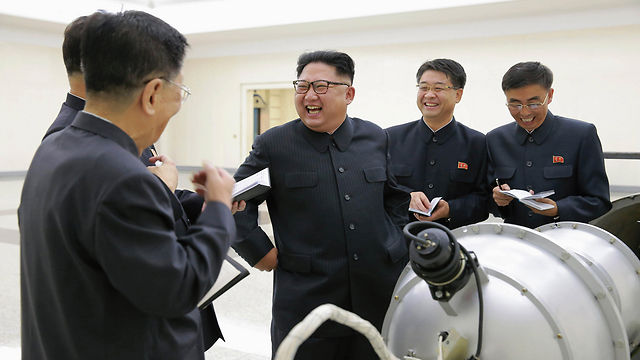
North Korean ballistic missile test
צילום: AFP
If North Korea can do it, so can Iran
Analysis: Great Western experts have been explaining to Israel how complicated it is to move from an accumulation of fissile material to a nuclear warhead on a missile—and here comes Pyongyang and proves them wrong. Now, IAEA inspectors are searching for Iranian nuclear experts at Iran’s supervised facilities; but they’re not there—they’re in labs in North Korea.
If North Korea, according to the images it is published and according to information gathered by Western intelligence agencies, has succeeded in turning fissile material into a nuclear explosive device mounted on a warhead of its self-produced missiles—so can Iran.

For years, North Korea has served as the Iranian missile industry’s active partner and development center. The Shahab-3 missiles are based on the North Korean Nodong missile. The Iranian Khorramshahr missiles, which have a 2,500-kilometer range, are actually a North Korean missile called HS-10.
Intelligence experts who have been monitoring the new Iranian and North Korean missiles point to identical changes in both of them, which are aimed at making them more accurate. This serves as clear evidence that North Korea’s technical ability is a perfect replication of the Iranian ability in the missile area, and in the nuclear area as well no doubt.

North Korean leader Kim Jong Un inspects loading of a hydrogen bomb into a new ICBM (Photo: EPA) (צילום: EPA)
During North Korea’s transition from the moment it exposed its fission ability more than five years ago to the past year, in which it has been demonstrating military nuclear abilities, it was in need of technological and financial aid. According to Western information, including reports in the New York Times, Tehran provided Pyongyang with knowledge and mainly money.
The technological-scientific cooperation between the two countries was characterized for years by a flow of information on missile construction and improvement from North Korea to Iran. In the past five years, however, the knowledge and money have been flowing in the opposite direction—from Iran to North Korea—particularly concerning the nuclear issue. When Iran is incapable of developing military nuclear abilities due to the supervision of the international community, it develops these abilities in a country like North Korea, which expelled International Atomic Energy Agency inspectors years ago.
By the way, Pakistan’s Ghauri missile, which is armed with a nuclear warhead, is a copy of the North Korean Nodong and the Iranian Shahab-3. Pakistan reportedly reached these capabilities with China’s help. And if Pakistan can do it and North Korea can do it, Iran—which is already a nuclear threshold state—can definitely do it.
In the past few years, there have been quite a few reports—some reliable and some not so reliable—on the presence of Iranian experts in long-range missile launches and in nuclear tests conducted by North Korea. One thing we know for certain is that Iranian experts have been guests of honor in public military parades in North Korea.
The ongoing development of North Korean missiles in Iran, as well as the Iranians’ involvement in the North Korean nuclear project and the North Korean nuclear abilities, which are an almost perfect replication of the Iranian abilities, are all strong cases that Prime Minister Benjamin Netanyahu can make to US President Donald Trump. But the joker in the pack is the fact that North Korea surprised the world with an operational nuclear weapon.
All the great experts in the West have been explaining to Israel how complicated it is to move from an accumulation of fissile material to a nuclear warhead on a missile. And here comes North Korea and not only proves them wrong, but also clarifies that they mislead Western leaders. Now, IAEA inspectors are searching for the Iranian experts at the supervised facilities in Iran. But they’re not there—they’re in labs in North Korea.
Iran isn’t hiding the fact that it keeps developing its nuclear capabilities, especially as it is permitted to do so in the signed agreement. The agreement also allows Iran to produce ballistic missiles. So as soon as it makes the decision, there will be no surprise—as far as Iran is concerned, it has already accumulated fissile material and armed the warheads with a nuclear weapon. Not on Iranian soil, but on North Korean soil.










